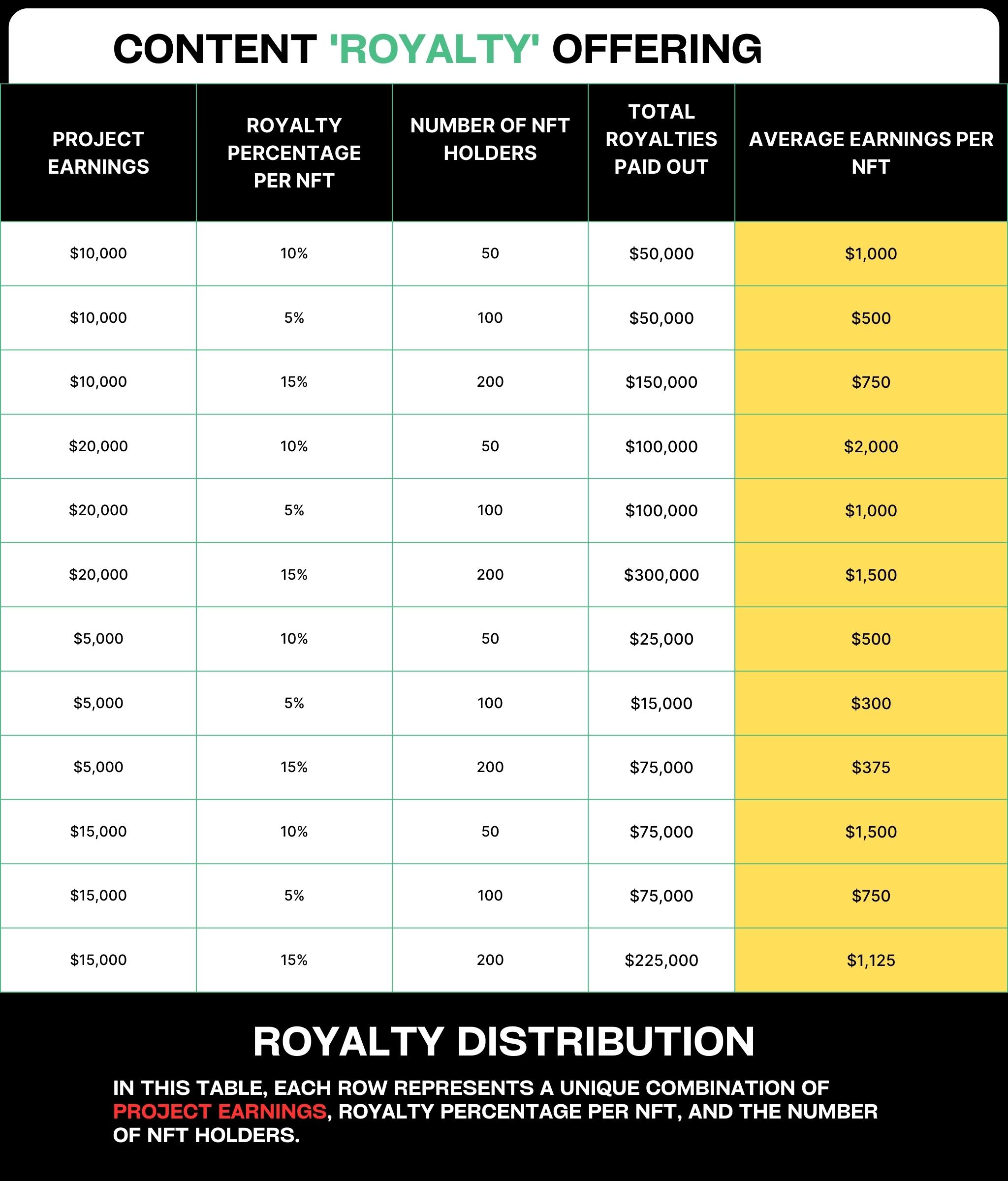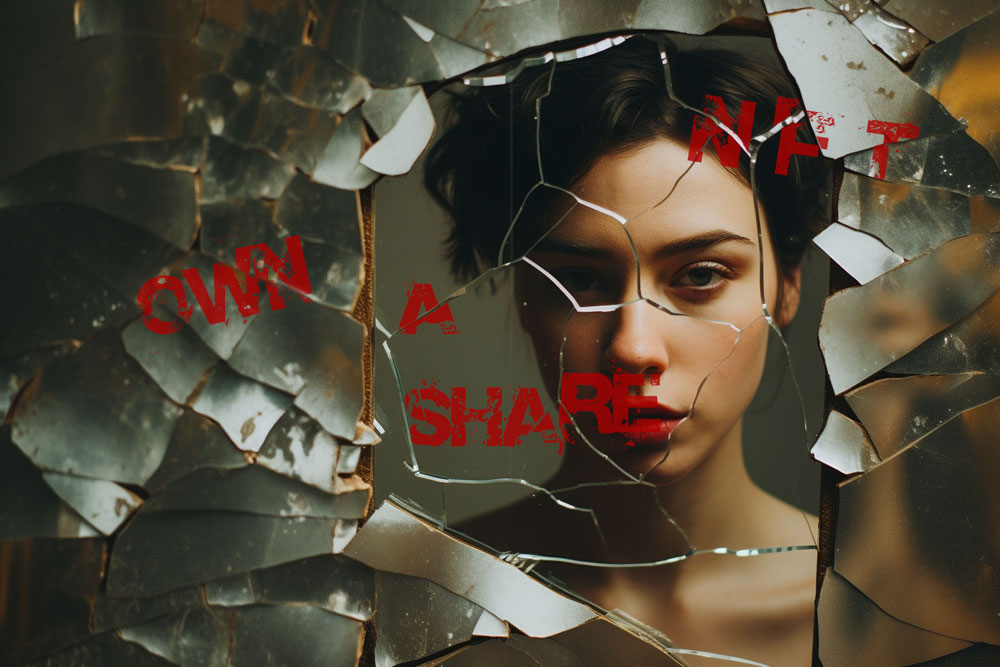
Fractionalize Ownership: Content Royalty Offering Using NFTs
NFTs provide a new approach to collaboration with fellow creators and brands, and one particularly intriguing concept that stems from the principles of smart contracts and digital footprints is the “Content ‘Royalty’ Offering Using NFTs.” This straightforward method pioneers collaboration and revenue-sharing within the social media platform. Creators offer NFTs that symbolize a portion of the earnings generated by premium content, encompassing videos, music, subscriptions, and other monetizable assets.
Can you make royalties from NFT?
You can make royalties from NFTs in various ways, primarily through smart contracts and digital footprints. These mechanisms provide you with a share of the earnings generated by specific content or projects. However, for this concept to become a reality, it requires a thriving ecosystem. Implementing this on a social media platform, for instance, creates an opportunity for creators and fans to benefit mutually by offering shares of the creator’s income or providing royalties through fractionalized shares of ownership for premium content or projects.
In this blog, I will discuss the mechanics of the Content ‘Royalty’ Offering and illustrate its exceptional profit potential, shedding light on what it means for creators and their supporters. This model introduces a fresh perspective on funding and collaboration, poised to revamp the creator economy. Keep reading as I dissect this innovative concept of fractional ownership, NFTs, and their boundless potential for creators and the communities that support them.
Table of Contents
The Content Royalty Offering is an innovative method of monetizing content on social media that represents a significant leap forward. It introduces novel ideas that have yet to be explored, similar to adding premium channels or subscriptions to your existing toolkit for content monetization. However, this approach goes further by fostering collaboration and merging the concept of crowdfunding.
How It Works:
Imagine you’re a creator with ideas for a project, whether it’s creating an educational video series, producing mesmerizing music, launching exclusive subscriptions, or curating premium content channels. Traditionally, you might seek funding through various means, such as crowdfunding or sponsorships. However, the Content ‘Royalty’ Offering presents a game-changing alternative.
With this model, creators have the option to tokenize their content through NFTs. Each NFT represents a fractional ownership stake in the revenue generated by the associated piece of content or project. For instance, if you’re a musician working on a new album, you can tokenize the album through NFTs, offering shares of future earnings to your fans and supporters.

Real-World Examples:
Music Album:
Let’s say you’re a musician planning to release an album. You tokenize the album into NFTs, and each NFT represents a share of the album’s earnings. Fans and backers can purchase these NFTs, effectively becoming stakeholders in your musical journey. As the album gains popularity and generates income from streaming platforms and sales, NFT holders automatically receive their share of the revenue.
Exclusive Subscription Service:
Consider a content creator launching an exclusive subscription service, offering premium content to subscribers. By tokenizing these subscriptions through NFTs, subscribers become fractional owners of the revenue generated by the service. As the subscriber base grows, the revenue increases, and NFT holders enjoy a proportional share.
Video Series:
A filmmaker plans to produce a captivating video series. They tokenize the series into NFTs, allowing backers to purchase shares of future earnings. As the series gains traction and generates income from advertising, views, or even merchandise sales, NFT holders receive their rightful portion of the earnings.
Collaboration:
Photographers and filmmakers can revolutionize collaboration with models and actors by offering NFTs that grant them a share of future project earnings. For instance, instead of upfront fees, a photographer can provide an NFT to a model, ensuring that as long as they hold it, they receive recurring income driven by the project’s success. If sold, future earnings go to the new owner, potentially creating a network effect of collaborators acquiring project shares and offering a fresh revenue stream for creators.
Influencer Marketing with NFTs:
In influencer marketing, sponsors can now pay influencers with NFTs, aligning their interests with content performance. As long as influencers hold the NFTs, they’re entitled to a share of revenue generated by sponsored content. While this fosters authenticity and compelling endorsements, influencers may face increased pressure to consistently promote content to maximize NFT earnings. This innovative approach has both pros and cons, transforming how sponsorships are structured.
This innovative model ensures that revenue distribution is automated and transparent, thanks to smart contracts. Creators and backers alike benefit from a shared financial interest in the success of the content or project.
In the following sections, we will go deeper into the potential benefits for creators and supporters within this ecosystem. The Content ‘Royalty’ Offering not only transforms how content is funded and monetized but also strengthens the bond between creators and their dedicated audience.
Average Earnings Per NFT Chart:

Explanation of the Table:
Project Earnings:
This column represents the total earnings generated by a specific project, ranging from $5,000 to $20,000.
Royalty Percentage per NFT: .
This column indicates the percentage of earnings allocated to each NFT holder, with values of 5%, 10%, and 15%
Number of NFT Holders:
I’ve kept a consistent number of NFT holders in each project earnings bracket, with options of 50, 100, and 200 holders.
Total Royalties Paid Out:
This value is the sum of royalties distributed to all NFT holders based on the project’s earnings and royalty percentage. It demonstrates how much money is shared with NFT holders.
Average Earnings per NFT:
This column calculates the average earnings per NFT holder within each scenario, providing insight into how much each NFT holder can expect to earn on average from the project.
The table allows you to compare different combinations of project earnings, royalty percentages, and the number of NFT holders, showing how these variables impact the total royalties paid out and the average earnings per NFT holder in each scenario.
How is Crowdfunding Better on Web3?
Crowdfunding on Web3 represents a transformative leap forward, where the power of smart contracts and decentralized platforms enables automatic royalty payments without the need for direct communication or reliance on traditional financial intermediaries.
In Web3, you invest in creators’ projects by acquiring NFTs, placing your trust in technology. If the creator succeeds, you benefit automatically, eliminating the need to request payment or depend on the other party’s responsiveness. This approach has the potential to make interactions more streamlined and anti-social in a productive way, freeing creators and backers from the hassles of traditional financing models. However, it comes with inherent risks, as projects may not always succeed, leaving NFTs with uncertain value – a common risk in any investment or business venture.

SocialFi exists at the juncture of Web3 and social media. It introduces a novel way of creating, managing, and owning content on social media platforms, where content creators, influencers, and participants gain control of their data and a remarkable degree of freedom.
Empowering Creators and Backers

The Content ‘Royalty’ Offering not only adds new layers to content monetization but also empowers creators and backers in profound ways. This section explores how this innovative model fosters collaboration, financial sustainability, and meaningful engagement within the creator economy.
Empowering Creators:
Creators can now start on ambitious projects with a new level of financial flexibility. Instead of shouldering the entire burden of production costs or relying on uncertain funding sources, they can tokenize their content and attract backers who believe in their vision. This approach democratizes access to funding, allowing creators of all backgrounds to bring their ideas to life.
Furthermore, creators can offer NFTs that represent shares of their content’s future earnings. This aligns their interests with their supporters, ensuring that success translates to shared prosperity. It also encourages creators to produce high-quality, engaging content, as their earnings are directly tied to performance.
Empowering Backers:
Backers, on the other hand, find themselves in a unique position of financial support and collaboration. By holding NFTs that represent shares of content, they not only contribute to the projects they believe in but also gain a vested interest in their success. This offers backers a sense of ownership and involvement that goes beyond traditional crowdfunding or sponsorship models.
Moreover, the automatic royalty payments facilitated by smart contracts provide backers with a hassle-free way to reap the rewards of their support. They no longer need to rely on creators to manually distribute earnings or communicate about revenue sharing. Instead, the blockchain-driven ecosystem ensures transparency and trust in the financial relationship.
In the following sections, we will delve deeper into the real-world implications of these empowered creators and backers, showcasing how this novel model enhances collaboration and paves the way for a more sustainable and engaging creator economy.
The Evolution of the Creator Economy

The Content ‘Royalty’ Offering represents a pivotal improvement in the ongoing growth of the creator economy. This section illuminates the shifts in dynamics, opportunities, and democratization that this innovative approach brings to the forefront.
Democratization of Funding:
Traditionally, creators faced significant barriers when seeking funding for their projects. Whether it was securing sponsorships, navigating complex crowdfunding campaigns, or grappling with the financial risk of upfront payments, these hurdles limited opportunities for many aspiring creators. However, the Content ‘Royalty’ Offering disrupts this paradigm by democratizing access to funding. Creators can now tokenize their content and attract backers, leveling the playing field and allowing creators of all backgrounds to turn their creative visions into reality.
Elimination of Middlemen:
Another transformative aspect of this model is the elimination of traditional financial intermediaries. In the past, creators often relied on agents, managers, or crowdfunding platforms to facilitate funding and revenue distribution. These intermediaries, while providing valuable services, came with associated costs and complexities. With smart contracts and blockchain technology, creators can directly engage with backers, and automatic royalty payments ensure that earnings are distributed efficiently and transparently. This direct creator-backer relationship fosters a more direct and engaging experience.
Decentralized Creative Control:
Furthermore, the Content ‘Royalty’ Offering empowers creators with decentralized creative control. Creators retain ownership of their content while offering backers a stake in the project’s success. This collaborative approach encourages creators to stay true to their artistic vision and fosters authenticity in the content creation process. Backers, in turn, have a direct impact on the projects they support, influencing the content landscape organically.
These shifts in dynamics signal a seismic change in how creators and backers engage with one another and the content they produce.
Conclusion
The Content ‘Royalty’ Offering marks a turning point in the creator economy, reshaping collaboration and financial sustainability. It democratically funds projects, removes intermediaries, and empowers creators with decentralized control.
As we familiarize ourselves with this evolution, it’s important to acknowledge the opportunities and risks it presents. This model invites us to reimagine how we fund ideas, placing our trust in technology and automated royalties. The future promises a fun collaborative change by bringing intended practical use cases to NFTs, content monetization, and the creator economy.
Now that you’ve grasped the concept of fractionalized shares through the ‘Royalty’ Offering Using NFTs, Let’s explore another method of fractional ownership below:

Imagine investing in creativity through ‘Own a Share Offering’: Buy NFTs that let you share in artists’ earnings, redefining your role as a supporter!
Learn more about Social Financialization by clicking on the link below.
See how it revolutionizes social platforms, allowing you to access your earnings instantly and use them directly through a unique charge card, acting as your personal ATM for the Social Platform. This approach raises the question:
“Why hasn’t this been done before?“

SocialFi is the future of social media. Join the Creator Economy and enjoy freedom, fairness, and fun. No more secrets, no more limits. 🚀







Leave a Reply